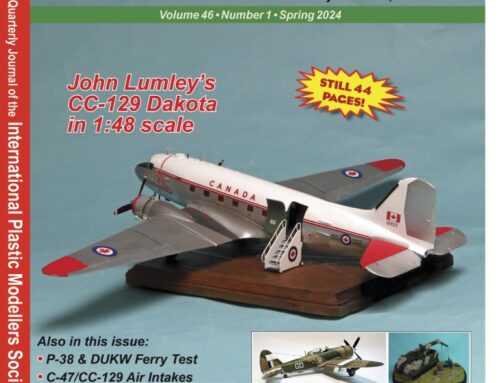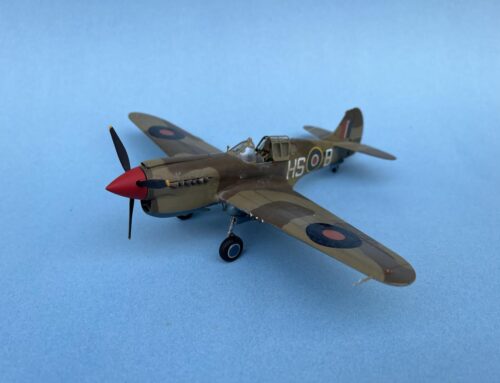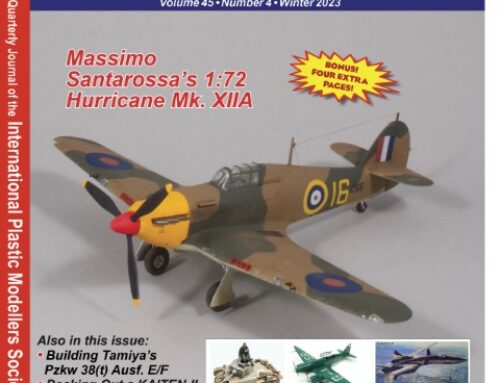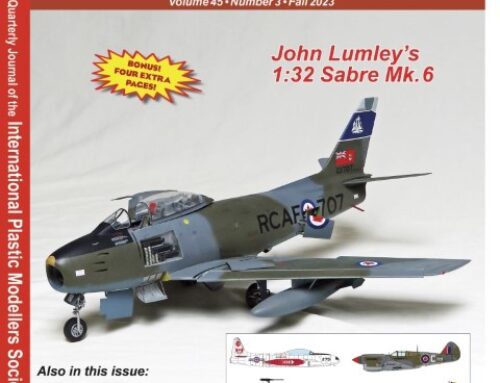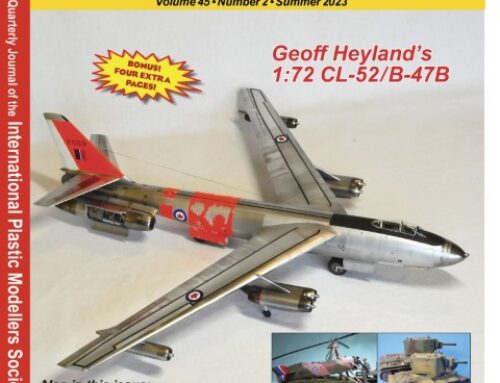General
Starting an IPMS Canada chapter in your area can be one of the most rewarding and fulfilling tasks that you can undertake in this hobby. While IPMS Canada promotes itself in publications, at model shows and on the Internet, the most important area for promotion is at the local chapter level. Getting a chapter started is a fairly simple task. However, promoting your chapter and having it grow will take time, patience and dedication.
Not all chapters are successful. Some fall by the wayside due to eventual disinterest, poor organization or personality conflicts. However, others thrive, providing their members with camaraderie, friendly competition and sources of modelling information that might not be readily available otherwise. Such chapters are excellent window displays for IPMS as a whole, and are the source of many new members. Accordingly, if you do not have a local chapter in your area but you are interested in forming one, here are a few considerations
Getting Started
To become an IPMS Canada chapter, you need only fill out a chapter application form and have a minimum of five members in your chapter. IPMS Canada requires that the each Chapter President and Chapter Liaison Member be members of IPMS Canada. This is necessary to ensure that IPMS members are administering the various chapters, and that they have an interest in promoting the image of IPMS Canada at the local level. Local membership dues, if they are collected, are the responsibility of the chapter. National IPMS Canada membership is not required to join local chapters, but it should be encouraged.
The first thing to do is to see if sufficient interest exists to form the chapter. You can contact the IPMS National Executive (NE), and obtain a chapter start-up kit to see what is required. The NE can also provide you with a list of IPMS Canada members who reside in your general area. These modellers will probably welcome the formation of a new chapter, and this is the best place to start organizing. Call them, broach the subject, and discuss possibilities and options with them.
Now you will need publicity – spread the word that you are starting a new IPMS Canada chapter. The local newspaper is a good place to start. Contact the editor, and explain what IPMS Canada is who you are, and what you are trying to do. Provide him with your contact information and, possibly, a good photo of one or two of your models. Keep a notepad by your phone to record the particulars of those who respond. Have a date and location set for the preliminary meeting, and encourage respondents to bring some of their models. Radio and television stations usually have a community announcement segment in their programming: use it as often as you can to promote the chapter. Also, you can place promotional material in libraries, drug stores, museums and any place where models are sold or displayed, and where modellers visit. The NE can provide you with a supply of posters and information brochures for distribution to these locations.
Find a local hobby shop or other business that sells kits and related items. They might be willing to display posters, kits and completed models to promote your club. These will be your best sources of continuing publicity. Speak to the owners, and emphasize that their support will almost inevitably lead to increased business. Take a copy of RT to show them that you represent a national group, thus increasing your credibility. They might provide IPMS Canada members with a small discount as an added incentive. A successful initiative is a display of completed models at the shops. This will go far to generate high levels of interest.
You will need a meeting place for your chapter, most preferably free of charge to your chapter. Experience has shown that a fairly large, centrally located establishment, accessible on weekends (if required) and with ample parking is by far the best venue for chapter meetings. Your local Parks and Recreation Departments can most likely provide you with suggestions. Facilities such as Legion halls, Kiwanis or Lion’s Club halls, museums, churches, schools, libraries and armouries are all good meeting places. There are many organizations that will be happy to let you use their facilities once you explain your aims. Note that homes tend to be inconvenient given the lack of space available, other family members being inconvenienced, lack of parking and a tendency towards exclusivity. This is especially true if you generate large numbers of members.
Meeting Frequency
Meetings should be held on a monthly basis, with perhaps a summer break during July and August. More frequent meetings tend to be burdensome for the organizers, and it probably does not allow enough time for model building between meetings. If more widely spaced, continuity is lost, dates are forgotten or misplaced, and attendance suffers. The monthly meeting concept seems to work the best for current chapters. Pick a designated day of the month, such as the second Sunday or the first Wednesday. Thus, members need not be constantly reminded every month. As well, publish or post the meeting dates so that members can plan in advance to attend.
Conduct of the Meeting
Most chapters seem to adhere to a four-phase organization for their meetings: casual arrival; business; entertainment; and closure.
Casual Arrival: This is important, as modelers arrive to register their models (for a competition or display), chat with other members, see what’s new, and discuss various tips and techniques. It’s a social period, and is important to get members into the “modelling” frame of mind. However, it should not go on too long, otherwise conversation will lag and the lack of directed activity might generate a sense of aggravation. Prolongation also encourages latecomers to be continually late. A suggestion is to state that, for example, arrivals take place between 7:00 PM and 7:30 PM, at which time the meeting is called to order.
Business: This should be kept to the minimum, consistent with what actually has to be discussed: future activities, changes in club policy, report on national activity, and so on. Let the Executive deal with the routine matters outside meeting time, with the general membership getting involved in matters of overall importance or complexity
Entertainment: This is the most flexible phase, and the key reason for the meeting. It can take many forms, as discussed below.
Closure: This phase allows for a bit more visitation among members, the closing of loops and the ending of the meeting on a happy, relaxed note.
Entertainment Suggestions
There are any number of appropriate entertainment topics and activities, limited only by the imagination of the membership. Here area few topics for your consideration:
Contests. This is considered by most current chapters to be an important part of the calendar, and some chapters hold contests at every meeting. Contests bring out the competitive spirit and the drive for excellence that leads to improved modelling skills. Member’s interest level is raised, and increased membership numbers promoted. There are many types of contests, such as
- Open – any type of subject,
- Set Scale – only one scale allowed,
- Set Era – only one time period (eg., the Korean War)
- Set Kit – only one “starting kit” permitted
Categories and rules are left to local chapter discretion – there are as many as you care to imagine. However, be sure that these topics are clearly defined, or you will probably waste much time in argument. The rules themselves are less important than that members adhere to them.
You may wish to use all or part of the IPMS Canada National Contest Rules, available here.
Judging. Judging is almost always a contentious problem. The appointment of “local experts” will possibly call their judgement or impartiality into question. An open vote, where all members cast a ballot, may lead to the complaint that subtle detailing and finishing has been missed by the less advanced modeler. It is suggested that the open vote method is as fair as any. As modelers advance in their skill levels, aided by the more advanced members, they will be more and more conscious of appropriate judging techniques. Accordingly, they will thus be better able to render an accurate judgement
Visual Presentations. Powerpoint and similar programs are probably the most current types of presentation that can be made. Film is available, but there are few projectors now available. Images of ships, aircraft, vehicles and many other modelling subjects are collected by members, and are fairly easily accessed. The key point is that an interesting and informative commentary is vital. Remember that some members may not have much idea of what they are seeing
Modelling Presentations. These can cover a vast range of topics: decals, airbrushing, detailing, sprue stretching, resin casting, hints and tips, vacuform canopies and a host of others. It’s one thing to tell someone about a new idea, and quite another actually to show them what it is. It is even better to show the chapter membership the new technique.
Guest Lecturers. There are many citizens who have had first-hand experience on modelling subjects. For military subjects, the local Legion will know of veterans who have worked on tanks, carriers, trucks and any number of related vehicles. Air Force and Naval Associations are equally good sources. A contest night dealing with, for instance, Canadian Armour, and that features a veteran crew commander of Centurion tanks who can discuss his service, will go far to increasing interest and skill levels, and possibly membership numbers as well if properly advertised.
Keeping Your Chapter Healthy
At your preliminary meeting, you should establish the basic rules for membership and for running the chapter. Will there be a membership fee? If so, what will it be? How will executive members be chosen? The most important thing here is simplicity. Although it is suggested that executive responsibilities be clearly defined so that duties are clear and the workload is fairly shared, large executives usually lead to large amounts of time being dedicated to “business” rather than to “modelling” at meetings. We recommend the time-honoured “President, Vice-President, Secretary, Treasurer, Chapter Liaison” organization. In fact, some of these might be combined: “Secretary-Treasurer,” or “Vice-President/Chapter Liaison”) are suitable.
Once you have found a meeting place, all modelers should be welcomed to your chapter meetings. This is especially true of junior modelers. These young people are the future of our hobby, and they should be encouraged at every opportunity. Equally, all forms of plastic modelling should be encouraged. Variety is the spice of life, and this certainly applies to this hobby. While Special Interest Groups (or “SIGs”) are popular, dealing with one type of model or other subject, your chapter should encourage all modelers to come out and take part in your meetings. The techniques of one modelling subject are almost certainly applicable to others.
Regular contact with the National Executive is a guideline requirement, nowadays easily done with email as well as by letter or postcard. Indeed, at the time of writing (January 2008) all of the 25 IPMS chapters in Canada have a direct email link to the National Chapter Liaison Officer. If your chapter decides to produce a newsletter or bulletin, hard or electronic copies can be sent to the National Executive, thereby maintaining the contact
Once established, your chapter will become a social venue as well as a hobby club. Plastic modelling is not a solitary hobby. Quite apart from interacting with other members to improve modelling skills, activities such as model displays, open houses, club barbeques and baseball challenges can also be also key features of your chapter.
Newsletters
There are many pro and con aspects to chapter newsletters. The style and complexity can range from the simple to the grandiose, as informal letter-style documents grow into full-blown chapter magazines. This is understandable because there is much satisfaction to be gained in seeing member’s work published. Initial ambition is high: lots of volunteers, much material and high levels of enthusiasm. Several months later, however, the deadlines approach with singular rapidity, material tends to fade away, and domestic imperatives reduce the volunteer pool. All to say that new editors should not be overly ambitious, at least until they have had enough time to gauge the ongoing requirements. Newsletters and magazines can be fun, but they can also be solid work that eats away at modelling time. Overall costs, circulation and administration all have to be addressed. That being said, there are currently a number of good chapter newsletters across the country. The electronic format of most allow them to be shared nationally, with some articles being provided by the chapters for inclusion in the National Magazine, “RT.” Indeed, some chapters have, from time to time, taken on the responsibility of providing enough material for a complete issue of RT. These become “Chapter Specials,” and are greatly welcomed by the national membership.
Conclusion
Plastic modelling is no longer an activity dedicated to children, if it ever was. The molding accuracy, detail and cost of recent kits, not to mention the waves of aftermarket resin, photo etch, decals, tools and associated items are clear indications that this is a hobby for all age groups. Certainly the cost of these things is an almost overriding factor in purchases and completion. The formation of active and dynamic local chapters goes far to helping all modelers achieve the best results they can.
Contact
The IPMS Canada National Executive Chapter Liaison member is Kerry Traynor. Kerry is most willing to help anyone start a new IPMS Canada local chapter. Kerry can be contacted at [email protected] .
IPMS CANADA
Chartered Chapter Guidelines
- The Chapter will, in all its meetings and affairs, conduct itself in such a manner as to ensure that no discredit is brought upon itself or IPMS Canada
- No person shall be prevented from becoming a Chapter member because of age, sex, race, religion or national origin.
- Non-member visitors will be made welcome at any open Chapter meeting.
- The Chapter will designate a current IPMS Canada member, who will maintain regular contact with the IPMS Canada National Executive
- A Chapter will have a minimum of five members, of whom a minimum of three must be members of IPMS Canada. The Chapter President must be a member of IPMS Canada. While IPMS Canada membership is not mandatory for other Chapter members, it is expected that it will be encouraged and promoted.
- When a potential Chapter submits complete and accurate application documents, IPMS Canada will issue new Chapter Charter.
- IPMS Canada will practice co-operation and non-interference with regard to local activities, except with respect to violations to the Charter.
- A Charter may be revoked or not renewed for failure to comply with these guidelines
Lignes directrices des sections locales de IPMS CANADA
- Lors de ses assemblées ou de ses activités, la section locale devra se comporter de façon ne pas suiré la reputation de la section locale ou IPMS Canada.
- Aucune personne ne devra etre exclue comme member de section locale pour raison d’age, de race, de langue, d’origine ethnique, ou de sexe.
- Les visiteurs qui ne sont pas membres doivent tre bienvenus lors de réunions ouvertes de la section.
- La section locale doit communiquer régulierement avec l’executif de IPMS Canada. La personne designee doit etre membre de IPMS Canada.
- La section locale doit avoir au moins de cinq membres. Trois de ses membres doivent etre membres de IPMS Canada. Le Président de la section locale doit etre membre de IPMS Canada. L’adhésion à IPMS Canada n’est pas obligatoire pour les autres members de la section locale, cependant, il est entendu qu’on doit encourager, favoriser et promouvir l’adhésion a IPMS Canada.
- Quand une section locale virtuelle presénte les documentes d’application justes, les charte de la section locale sera émises par IPMS Canada.
- IPMS Canada donnera son concours aux activités des sections locales, amis n’y interviendra pas, sauf dans le cas de violation aux lignes directrices ou à la charte.
- La charte d’une section locale peut etre revoquée par IPMS Canada ou cette derniere peut refuser de la renouveler, le cas echeant, pour toute violation aux lignes directrices ou à la charte.


